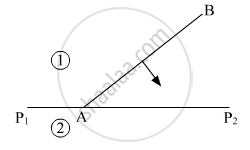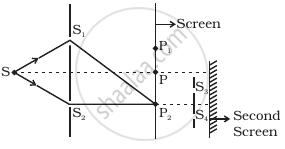Advertisements
Advertisements
Question
Explain the construction of plane wavefront using Huygens’ principle.
Solution

a. A plane wavefront is formed when point of observation is very far away from the primary source.
b. Let PQR represent a plane wavefront at any instant. According to Huygens’ principle,all the points on this wavefront will act as secondary sources of light sending out secondary wavelets in the forward direction.
c. Draw hemispheres with P, Q, R…. as centres and ‘ct’ as radius. The surface tangential
to all such hemispheres is P1Q1R1…. at instant ‘t’. It is a new wavefront at time ‘t’.
d. The plane wavefronts is propagated as plane waves in homogeneous isotropic medium.They are parallel to each other.
e. PP1N1, QQ1N2, RR1N3 are the wave normals at P, Q, R respectively. These wave normals show the direction of propagation of plane wavefront.
f. The new wavefront P1Q1R1 is parallel to primary wavefront PQR.
APPEARS IN
RELATED QUESTIONS
Using Huygens's construction of secondary wavelets explain how a diffraction pattern is obtained on a screen due to a narrow slit on which a monochromatic beam of light is incident normally.
What is the shape of the wavefront in the following case?
Light emerging out of a convex lens when a point source is placed at its focus.
What is the shape of the wavefront in the following case?
The portion of the wavefront of light from a distant star was intercepted by the Earth.
You have learnt in the text how Huygens’ principle leads to the laws of reflection and refraction. Use the same principle to deduce directly that a point object placed in front of a plane mirror produces a virtual image whose distance from the mirror is equal to the object distance from the mirror.
Consider a plane wave front incident on a thin convex lens. Draw a proper diagram to show how the incident wave front traverses through the lens and after refraction focusses on the focal point of the lens, giving the shape of the emergent wave front.
Use Huygens' principle to verify the laws of refraction.
Huygens' principle of secondary wavelets may be used to
(a) find the velocity of light in vacuum
(b) explain the particle behaviour of light
(c) find the new position of a wavefront
(d) explain Snell's Law
Derive the law of reflection using Huygen’s Wave Theory.
Answer the following question.
Define the term wavefront. Using Huygen's wave theory, verify the law of reflection.
Define a wavefront. Using 'Huygens' principle, draw the shape of a refracted wavefront, when a plane wave is incident on a convex lens.
Define the term 'wavefront of light'. A plane wavefront AB propagating from a denser medium (1) into a rarer medium (2) is incident of the surface P1P2 separating the two media as shown in fig.
Using Huygen's principle, draw the secondary wavelets and obtain the refracted wavefront in the diagram.

According to Huygen's construction, relation between old and new wavefront is ______.
What is the geometrical shape of the wavefront for:
- Light diverging from a point source?
- The pattern of wavefront of the light from a distant star intercepted by earth?
What is the phase difference between any two points lying on the same?
The inverse square law of intensity is valid for a
Huygen's conception of secondary waves ______.
Figure shows a standard two slit arrangement with slits S1, S2, P1, P2 are the two minima points on either side of P (Figure). At P2 on the screen, there is a hole and behind P2 is a second 2-slit arrangement with slits S3, S4 and a second screen behind them.

Is Huygen’s principle valid for longitudinal sound waves?
What is the shape of the wavefront on earth for sunlight?
How is a wavefront different from a ray?
Using Huygen's wave theory of light, show that the angle of incidence is equal to the angle of reflection. Draw a neat and labelled diagram.
Represent diagrammatically how the incident planar wavefronts of wavelength λ pass through an aperture of size d, when d is approximately equal to λ.
